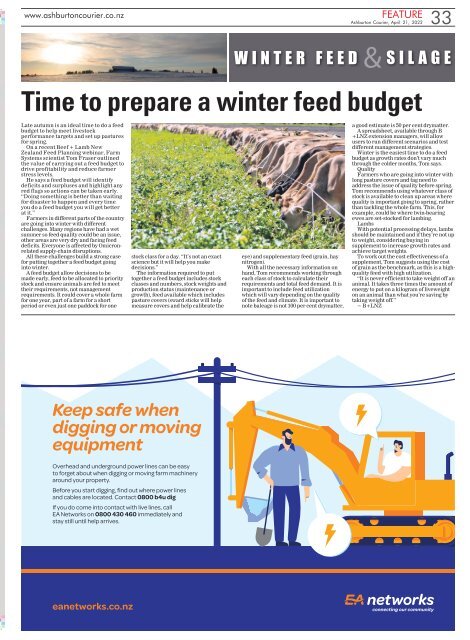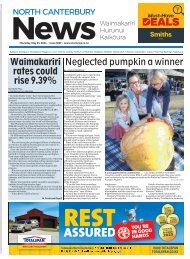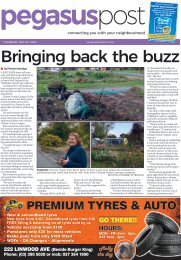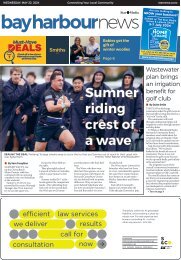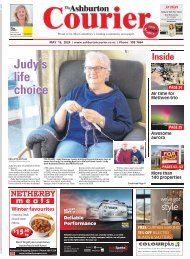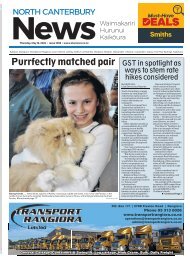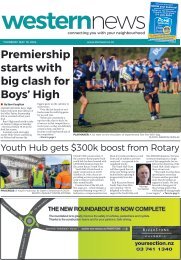Ashburton Courier: April 21, 2022
You also want an ePaper? Increase the reach of your titles
YUMPU automatically turns print PDFs into web optimized ePapers that Google loves.
www.ashburtoncourier.co.nz<br />
FEATURE<br />
<strong>Ashburton</strong> <strong>Courier</strong>, <strong>April</strong> <strong>21</strong>, <strong>2022</strong><br />
33<br />
WINTER FEED<br />
&<br />
SILAGE<br />
Time to prepare awinter feed budget<br />
Late autumn is an ideal time to do afeed<br />
budget to help meet livestock<br />
performance targets and set up pastures<br />
for spring.<br />
On arecent Beef +Lamb New<br />
Zealand Feed Planning webinar, Farm<br />
Systems scientist Tom Fraser outlined<br />
the value of carrying out afeed budget to<br />
drive profitability and reduce farmer<br />
stress levels.<br />
He says afeed budget will identify<br />
deficits and surpluses and highlight any<br />
red flags so actions can be taken early.<br />
“Doing something is better than waiting<br />
for disaster to happen and every time<br />
you do afeed budget you will get better<br />
at it.”<br />
Farmers in different parts of the country<br />
are going into winter with different<br />
challenges.Many regions have had awet<br />
summer so feedquality could be an issue,<br />
otherareas are very dry andfacing feed<br />
deficits. Everyone is affected by Omicronrelated<br />
supplychain disruptions.<br />
All these challenges build astrong case<br />
for putting togetherafeed budget going<br />
into winter.<br />
Afeed budget allowdecisions to be<br />
made early, feed to be allocated to priority<br />
stockand ensure animalsare fed to meet<br />
theirrequirements, not management<br />
requirements. It could cover awhole farm<br />
for one year,part of afarm for ashort<br />
period or even just onepaddock for one<br />
stock class for aday. “It’s not an exact<br />
science but it will help youmake<br />
decisions.”<br />
The information required to put<br />
togetherafeed budget includes stock<br />
classes and numbers, stockweights and<br />
production status (maintenance or<br />
growth), feed available whichincludes<br />
pasture covers (sward stickswill help<br />
measure covers and help calibratethe<br />
eye) and supplementary feed(grain,hay<br />
nitrogen).<br />
With all the necessary information on<br />
hand,Tom recommends working through<br />
each classofstock to calculate their<br />
requirements and total feed demand.Itis<br />
important to include feed utilization<br />
whichwill vary depending on the quality<br />
of the feed and climate. It is important to<br />
note baleage is not 100 per cent drymatter,<br />
agood estimate is 50 per cent drymatter.<br />
Aspreadsheet, availablethrough B<br />
+LNZ extension managers, will allow<br />
users to run different scenarios and test<br />
different management strategies.<br />
Winter is the easiest time to do afeed<br />
budget as growth rates don’t varymuch<br />
throughthe colder months, Tomsays.<br />
Quality<br />
Farmerswho are goinginto winter with<br />
long pasture covers and tag need to<br />
addressthe issue of quality before spring.<br />
Tom recommendsusing whatever class of<br />
stock is available to clean up areas where<br />
qualityisimportant going to spring,rather<br />
than tackling the whole farm. This,for<br />
example, could be wheretwinbearing<br />
ewes are setstockedfor lambing.<br />
Lambs<br />
With potential processing delays, lambs<br />
should be maintained and if they’re not up<br />
to weight, considering buyingin<br />
supplement to increase growth rates and<br />
achievetarget weights.<br />
To workout the cost effectiveness of a<br />
supplement, Tom suggests using the cost<br />
of grainasthe benchmark, as this is ahighquality<br />
feedwith high utilization.<br />
“Itisneverefficient to take weight off an<br />
animal. It takes threetimes the amount of<br />
energytoput on akilogram of liveweight<br />
on an animalthan whatyou’re saving by<br />
taking weightoff.”<br />
~B+LNZ<br />
Keep safewhen<br />
diggingor moving<br />
equipment<br />
Overhead and underground powerlines can be easy<br />
to forget about when diggingormoving farm machinery<br />
around your property.<br />
Beforeyou start digging,find outwhere power lines<br />
and cables arelocated. Contact 0800 b4u dig<br />
If you do come intocontact with live lines,call<br />
EA Networkson0800 430 460 immediately and<br />
staystill untilhelp arrives.<br />
eanetworks.co.nz


